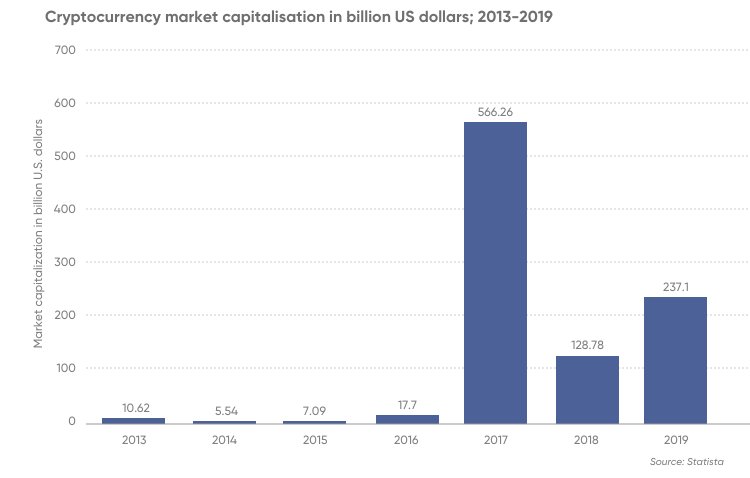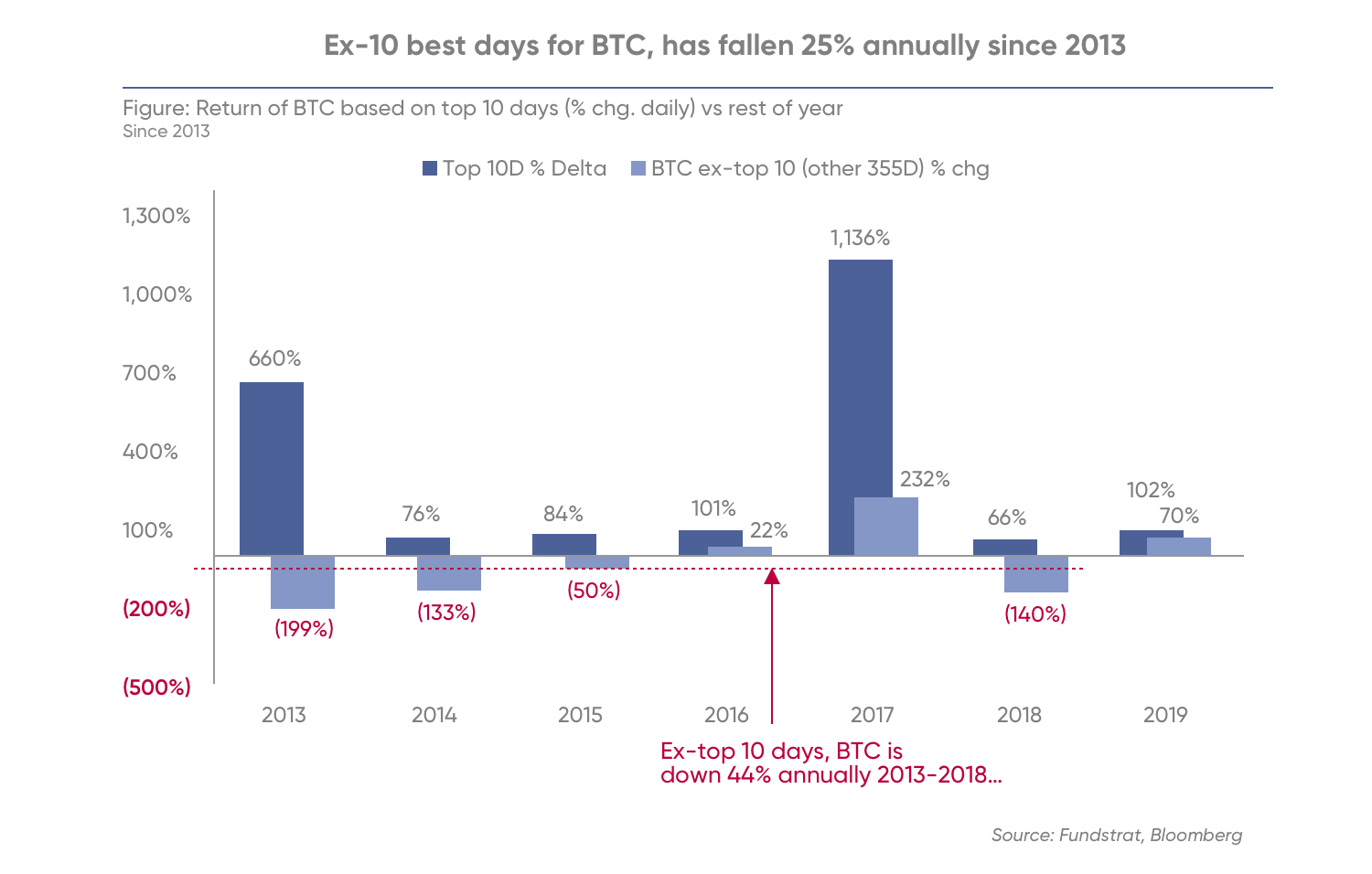A brief history of the crypto industry
The cryptocurrency industry has grown substantially since Satoshi Nakamoto published the original Bitcoin whitepaper in 2008. More than a decade later, most people are aware of the terms “Bitcoin” and “cryptocurrency”.
In 2017, at the peak of the interest in cryptocurrencies, “How to buy BTC” was the third-ranked “How to …” Google search. While the market capitalisation of the crypto asset class has fluctuated wildly with price swings, it nevertheless increased from roughly $10bn (£8.1bn, €9.1bn) in 2013 to $237bn by the end of 2019. Similarly, over the past five years, the growth in Bitcoin unique accounts and transactions has averaged nearly 60 per cent per year.


Since 2009, the crypto space has created its fair share of wealth for early adopters and investors. Some, like the Winklevoss twins or Changpeng Zhao, used their investment gains to build businesses in the crypto ecosystem. The Winklevoss twins, for instance, built the Gemini exchange, while Changpeng Zhao founded Binance, one of the largest cryptocurrency exchanges in the world.
There are plenty of other examples. Valery Vavilov used his early interest in blockchain technology to start a Bitcoin miner Bitfury. Today, the company also produces and sells hardware for Bitcoin mining and generates over $400m in revenues. Anthony Di Iorio financed some of the early development of the Ethereum blockchain and has since invested in other crypto projects like Qtum, Vechain and Zcash.
Crypto outlook: can you make money with cryptocurrency?
While the early gains in crypto have already been made, the industry remains in the initial stages of development. The internet, for example, was developed in 1969 and the World Wide Web was introduced in 1990. By comparison, cryptocurrencies have been around for just over a decade.
Recent research by venture capital firm a16z shows that the crypto space evolves in cycles. A cycle generally starts with an increase in prices of the crypto assets, driving social and traditional media buzz. The coverage and excitement bring more people into the space, contributing new code, ideas and creating new projects. This eventually starts the next cycle.
To date, we have seen three crypto cycles that peaked in 2011, 2013 and 2017. Despite price falls in each cycle, there has been consistent growth in developer activity, social media activity and a number of start-ups created in the space. The peak of the next cycle is likely to coincide with new technological breakthroughs and rising crypto prices.
Long-term price appreciation is likely to be supported by increased interest in cryptocurrencies as an asset class by institutional investors. The daily average volume of cryptocurrencies traded is just 1 per cent of the foreign exchange market. Despite growing to over $200bn in market capitalisation, crypto assets are still a fraction of the global equity market ($71tr at the end of 2019) and the global debt market (more than $100tr at the end of 2018), not to mention global real estate.
Recently disclosed position in Bitcoin by Paul Tudor Jones as an inflation hedge and the rapid growth in assets under management of Grayscale Investments are early but positive signs of institutional adoption.
This backdrop presents investors and traders with opportunities to make money in the crypto space.
How to make money with cryptocurrency: six strategies to consider
There are many different ways to make money with cryptocurrency and generate income in the crypto space. Given the inherent volatility of crypto assets, most involve a high degree of risk while others require domain knowledge or expertise.


Investing
Investing is usually associated with taking a long-term view by buying and holding assets for some time. Crypto assets are generally well suited to a buy and hold strategy. They are extremely volatile in the short term but have tremendous long-term potential. Research by investment firm Fundstrat shows that the majority of Bitcoin gains come in the 10 best trading days of the year. In fact, missing these days every year between 2013 and 2018 would result in a negative 44 per cent annual return.


Because of this inherent volatility, long-term investing is one of the better approaches to make money through cryptocurrency. As with any investment, crypto should be considered in the portfolio context based on your investment goals and risk tolerance.
Trading cryptocurrency for profit
The main difference between trading and investing is the time horizon. While investing is a long-term endeavour, trading is meant to exploit short-term opportunities. Trading cryptocurrencies requires certain skills and experience. Specifically, the ability to read charts and understand technical indicators. Having an in-depth knowledge of blockchain and different projects, however, is not required. This way of making money is more about understanding the price action in the historical context and using that to predict future prices, often on a short-term basis.
To make money online trading cryptocurrency, investors can either buy and sell actual crypto coins or use derivatives instead, such as a contract for difference (CFD). When you trade crypto using CFDs, you speculate on the direction of the underlying asset’s prices without actually owning it.
You can either take a long or short position, depending on whether you expect the price of an asset to rise or fall. Therefore, CFDs give you an opportunity to profit from both bullish and bearish price movements in underlying securities.
Trade Bitcoin to US Dollar – BTC/USD CFD
CFDs allow trading on margin, providing you with greater liquidity and easier execution. However, note that CFDs are a leveraged product; therefore, profits, as well as losses, are magnified.
You can learn how to make money trading cryptocurrency CFDs with Capital.com’s comprehensive guide and trade them using our AI-powered trading platform
Staking and Lending
Staking and lending are quite similar and allow investors to make money with altcoins. Staking essentially means locking coins in a cryptocurrency wallet and receiving rewards to validate transactions on a Proof of Stake (PoS) network. Instead of mining, the PoS algorithm chooses transaction validators based on the number of coins they committed to stake. PoS does not require expensive hardware and is much more energy-efficient. Cold staking is also an option, allowing investors to stake coins while holding them in a secure offline wallet. Tether, NEO and Stellar (XLM) are some of the coins you can stake.
With staking, investors are lending coins to the network, to maintain its security and verify transactions. Another option to earn money with crypto is to lend coins to other investors and generate interest on that loan. Many platforms facilitate crypto lending, including exchanges, peer-to-peer lending platforms and decentralised finance (DeFi) applications.
Crypto social media
In 2016, Dan Larimer launched Steemit, the world’s first blockchain-based social media platform. The platform rewards users with its native coin, STEEM, for creating and curating content. Steemit ran into some troubles after 2017 and the number of users has been declining since. However, multiple other platforms have been built on the initial idea of rewarding users for creating content. Narrative, Sapien and Scorum are some of the examples.
Mining
Mining is a crucial component of the Proof of Work (PoW) consensus mechanism and is one of the oldest ways of making money with crypto. It is a process of verifying transactions and securing a PoW network. Miners are rewarded with new coins, through block rewards, for performing these functions. In the early days of Bitcoin, mining could be done on a desktop computer but today requires specialised mining hardware.
On the subject of supporting a network, running a masternode can also be profitable. Masternodes are wallets that host a copy of the entire network.
Both of these methods require technical expertise and significant upfront and ongoing investment.
Airdrops and forks
Airdrops and forks are the crypto equivalent of being in the right place at the right time. Airdrops are free tokens, usually distributed by an exchange to generate awareness and create a large user base for a project. Forks are essentially changes or upgrades in a protocol that create new coins. When a blockchain forks, holders of the coins on the original chain typically get free tokens on the new network.
Always stay on top of the latest crypto market news with Capital.com to spot the best trading opportunities.
